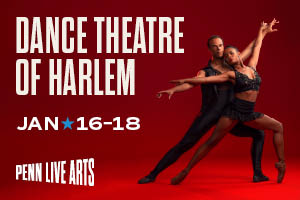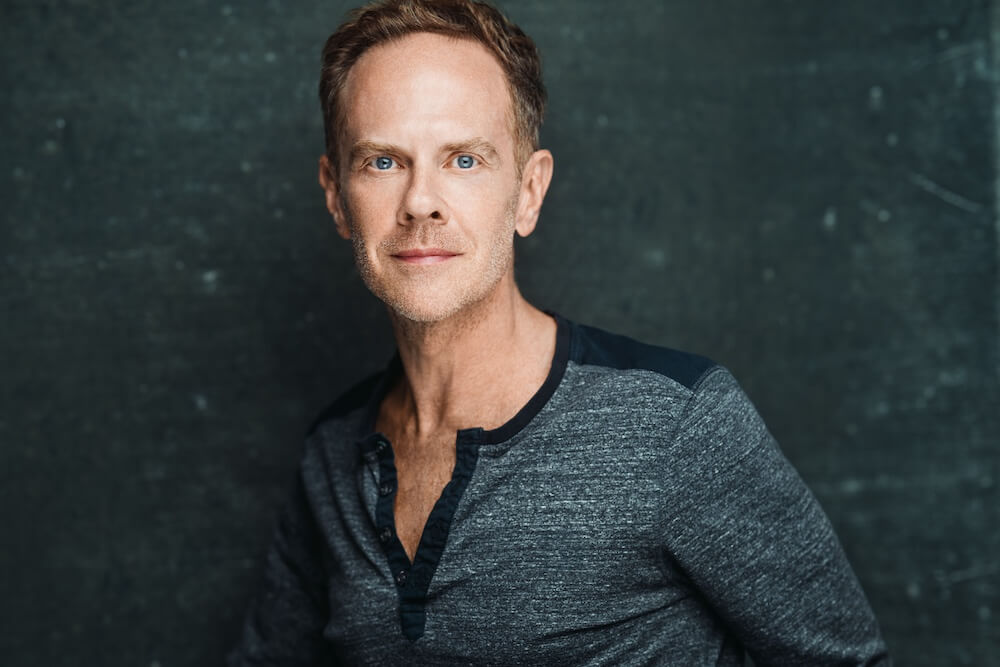Audience members who were single separated from those in a relationship. A puppet show, a miniature poodle, a toy piano, Germanic-looking schoolgirl twins. Moderators who rode in on a blue motor scooter, indie rock ballads blaring. Cookies passed out instead of answers during Q&A. A drag queen dance party on stage as we exited the theatre. This Scratch Night was anything but the expected.
Which begs the question, what do you usually expect when you go to see a works-in-progress showing? Is the feedback format after this (or more formal shows) meant to be more beneficial for the artists or the audience?
These questions were foregrounded for me throughout the evening by the evening’s orchestration by our moderators, Gabrielle Revlock and Nicole Bindler. Their Dance Apocalypse opened with a short puppet show; Revlock and Bindler’s fists erupted through a screen in an awkward flirtation of small stop-motion flutters. Humorous interchanges (“I can smell your makeup.”/“What makeup?”) peppered the conversation as they popped up from behind the “stage” to smoosh their faces together or caress each others’ hair. This brief sketch (capped with Revlock stating “When I was younger–I didn’t know if I was a boy or a girl,” followed by awkward audience giggles, and a long pause from Bindler before her response: “Do you know now?”) was less of the “piece” they were showing for Scratch Night than their extended hostessing performance. Entering like superstars (complete with theme song) for the Q&A session following, Revlock and Bindler ran into the audience and asked questions of each other in “mock-audience” voices. Farcical responses were delivered as the two set up each others’ jokes, never actually answering the audience members’ queries.
I’m laughing my butt off, but how much of what they said about their work am I supposed to take seriously? Why was I separated from my single friends? What did that have to do with gender and performance, the focus they asked for in their introduction? Cookies are our only answer; is that enough? Perhaps this is the zen koan of Q&A sessions.
Performed to composer Paul Stern’s live toy piano, Katherine Keifer Stark’s Falling into Here featured Stark and Megan Mazarick in space demarcated by a pair of yellow parentheses on the floor and dotted with two wooden chairs. The dancers swept, spun, settled, and collapsed. One dancer jutted her flexed foot out, which became a platform for a bicep. A long sequence of multilevel push-and-pull felt like a seesaw ride. As the piece rambled along, they were never on the same plane–one sat, the other lay down. The other lay down, one stood.
As the work concluded, Revlock and Bindler reappeared, walking a black toy dog and dressed in kitschy red and yellow schoolgirl outfits. They initiated–and then distracted from–Stark’s Q&A. It was difficult to maintain focus on Stark’s work, to give or hear feedback while our larger-than-life emcees led children onstage to play with a pup and parade around with lollipops.
I admire their dedication to challenging a given structure, and the humorous way they shed light on our expectations and assumptions–our ways of viewing (and judging!) work in what is supposed to be an informal setting. But when this happens, it ceases to be a fun experiment for me, and starts to impinge on their fellow artists’ equal rights to traditional, informative feedback. And I wonder: can these two exist simultaneously?
Our hostesses introduced Kate Watson-Wallace’s excerpt from Mash Up Body, a repeat visitor to Scratch Night, by reorganizing us around the stage, and delineating rules for watching which served mostly to identify the work’s lack of linear narrative and meandering logic. I recognized familiar movement from the January show: dancers kissed the air, laughed, and made retching noises. This time, the movement was more structured, with entrances and exits clearly defined, and ensemble work broken up into duets or solos. Bodies formed lines–horizontal and perpendicular to the front of the stage–and dancers kept returning to face front.
One such moment felt integral to the piece: Wawa walked forward, surrounded by the others. Dancers poked and prodded, jiggled her breasts and slapped her rear-end. Or so I was later told by audience members with a clearer view; all I was privy to from my vantage point was the huddled masses’ backs.
Why are we seated in a “U” shape if the dance is so frontal? Facial expressions are blocked from me, remnants of smiles fading as they change facing. Often, I find myself left wanting to see what those in the front are viewing. When asked about it, Wawa notes that the size of the space they plan to perform in is much larger–but never addresses the facing. It leaves me confused, again wondering who this format was designed to benefit.
In Watson-Wallace’s Q&A session, our outrageous moderators appeared ready for a night out in sequined leggings and a cocktail dress, and instructed only five people to provide feedback–but they were required to come on stage and touch Watson-Wallace’s shoulders, arms, or feet while doing so. Their proximity made the whole exchange awkward as the respondents often interrupted themselves with acknowledgement of that discomfort.
The shift in expectation–not taking this showing too seriously–is a refreshing change, and definitely highlights my own assumptions and expectations about these events, as well as some of the more problematic aspects of their structure. The audiences at Scratch night are offered beer and snacks, and in this looser environment, the freedom this hosting provides is more successful than I think it would be at another venue. But, even as I exit laughing at the tongue-in-cheek play of men in drag dancing us to a close, I leave feeling that I wasn’t really given answers or insight into the works I saw and that the value of instant, gut-response verbal feedback wasn’t available to the choreographers because of the talkback performance. Yes, they get written responses, and yes–just showing a work is enough to provide a wealth of information for the artist (and audience). But this Scratch Night feels like it was for the hosts more than the audience or creators. It leaves me with another question: who is this feedback process for? And maybe, that is the point they are making all along.
Scratch Night, presented by FringeArts. The LAB at Painted Bride Arts Center, March 4, 2013.






